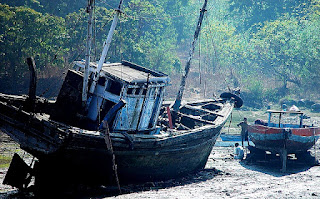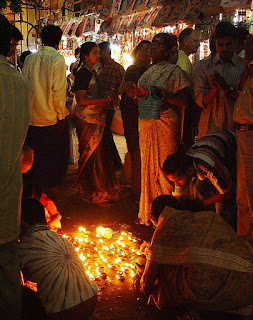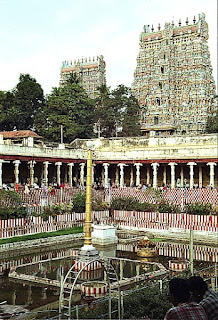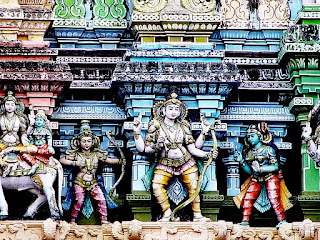We had always
wanted to go to India but couldn’t think of a reasonable excuse.
In 2004
Sterlite Industries, with head offices in Mumbai and smelters on the port of
Tuticorin in Tamil Nadu, contacted us expressing an interest in MINEMAN
Systems.
They asked for a submission and we felt that to do a proper
submission we needed to
visit both Mumbai and Tuticorin and talk to them face-to-face. Just
before we left there was a terrible tsunami and both Tamil
Nadu and Sri Lanka were badly affected and we thought that the trip would be
called off. Tuticorin was lucky in that it was in the shadow of Sri Lanka and
was hardly damaged at all. We had to
fly to Madurai to get to Tuticorin and it was decided that I would stay there because we didn’t know what we would find on the coast, despite Sterlite’s
assurances.
So off
to India we went.
We
arrived at Mumbai in the evening to a wonderful sunset. We quickly found out that all
sunsets in Mumbai are wonderful because of the pollution. We drove in from the
airport in a traffic jam. Actually it wasn’t a traffic jam it was just normal
flow for Mumbai traffic. The noise, colour and smells were exhilarating. There
were people everywhere. We were introduced to the Indian way of driving which
entails constantly honking the horn.
We stayed at the Taj Mahal Palace, Colaba. It is a wonderful Victorian building that looks imposingly over the water. The hotel was built in 1902 by the Parsi industrialist JN Tata
as a response to him being refused admission to a British owned hotel.
The first night we just wandered around the Colaba Causeway taking in the smells, noise, pollution and colour of Mumbai.
The breakfast room, with the sun rising over the Apollo Bunder waterfront, was a fabulous
place for us to plot our days activities.
The first day we took a ferry to Elephanta Island. The pollution was so bad that Mumbai disappeared from view and other boats and islands loomed like ghosts through the smog.
The weather was quite warm and there was a long walk to the caves but it was well
worth the trip. As with everywhere else we were to go, there were very few Europeans.
So we stood out quite a lot. This produced some problems, especially for me being blond.
The views going back into Mumbai were fabulous as the Taj Mahal and the Gate Way to
India gradually came into few.
 |
| The Caves are believed to be built by the Chalukyas between 550-750AD. They are carved out of the rock face of the mountain. |
 |
| The Taj Palace from the water |
We walked around Colaba and were appalled at the filth and rubbish everywhere.
The rubbish encouraged all sorts of scavengers from feral dogs to crows to people.
The city infrastructure of plumbing and electricity was in a condition of decay.
A small boy came up to my side, Omar asked me to roll down the window which I
reluctantly did. The boy looked up at me and grinned, he pointed to his eyes which
were an astonishing blue, then pointed at my blue eyes, he shook my hand and ran
away giggling and forgot to ask for anything. The second was when I saw a boy walking
up to my window. He had a newly healed stump for an arm and was waving it at me.
I looked away. It was then that I heard the sound of his fingernails on his whole arm and
the thud of the stump banging on the window. Luckily the lights changed.
Another thing that upset our Western
sensibilities was the lack of public facilities.
This has lead to a habit of
the locals defecating and urinating in public. The slum areas are
very
confronting with a mass of humanity living literally on top of each other.
Among the dirt and rubbish the women and children sparkled with their
cleanliness and colour.
The next day we visited both the Prince of Wales Museum and the Victoria Terminus (now renamed Chhatrapati Shivaji Terminus).
The Price of Wales Museum was begun in 1905 and completed in 1914. During WWI it was converted into a military hospital and wasn't officially opened until 1923. It is in need of some strong tender loving care and a vast injection of money. Its collection of Nepalese and Tibetan art and sculpture is worth seeing. A lot of the exhibition space is water-damaged and the natural history section is a bit moth-eaten and dusty.
 |
| The Museum was designed by George Wittet in the Indo-Saracenic architectural style. He also designed the nearby Gateway Of India |
The most whimsical and magnificent building we saw was the Victoria Terminus.
Gargoyles everywhere, wrought iron, statues and cameos but, in true Indian style, also
with cripples, rubbish and a teeming mass of humanity. It is a fabulous confection of the
Italian Gothic style. The station was completed in 1888, for the Great Indian Peninsular
Railway with designs by the English architect, FW Stevens.
An unpleasant experience was visiting the jewellery market. The
market was a maze of
little streets and shops. It was a predominately Islamic
area and the women were all
veiled. I stood out. We had heard about Eve Teasing and this was the only place it happened to me. I was walking behind Omar and men would lurch a couple of inches into my path so they could grab my arm or just bump into me. I was aware of men just stopping to stare at me, and whenever I had to wait for Omar a small crowd started to form.
We got out of there.
veiled. I stood out. We had heard about Eve Teasing and this was the only place it happened to me. I was walking behind Omar and men would lurch a couple of inches into my path so they could grab my arm or just bump into me. I was aware of men just stopping to stare at me, and whenever I had to wait for Omar a small crowd started to form.
We got out of there.
The buildings in Mumbai looked as if they
had settled into genteel decay but you could
image how magnificent Mumbai would
have looked when it was Bombay and owned by
the East India Company and the Raj
ruled.
We found plenty of great restaurants and realised all the warnings we had been
given about the food in India were
unjustified. You can be careful without being paranoid.
We loved all the small shops and the
enterprise of the shop owners. The store names used
a fractured
English that raised a smile i.e. Dynamic Eng. Corp., Delux Copy Centre,
Supreme Mattresses, Lovely Silk Store and the Okay Silk Stores. The signage was so colourful and the combination of English and Sanskrit made for wonderful
patterns.
One neighbourhood that we enjoyed was Malabar Hill. It was a quieter and had a beautiful
sacred tank
surrounded by temples. Around the tank are temples and rest houses for pilgrims who come to ritually bath in it. This area also has a couple of major public gardens. The main garden is known as the Hanging Gardens (Pherozeshah Mehta Gardens). It is built over three reservoirs that supply the city with fresh water. The oddest thing about the garden is that
it is full of decidedly weird topiarised animals

Walking down from Malabar Hill we saw dozens of Vultures, the avian kind, circling the
forest region. We mused on their food source, later we found that we were adjacent to the Parsee cemetery and they lay the dead out in the open for the birds. So much for cute floral and fauna. The birds then became known as the cadaver birds. It was disconcerting to see them hovering over a hospital for the disabled. They also hovered over the hotel swimming-pool. Maybe they thought that the very white bodies of the western tourists looked like very dead Parsees.
During our stay at the Taj Palace we watch the upper class of Mumbai hold weddings, parties and exhibitions. It was a great place for people watching. The young women were all beautiful and dressed in exquisite silk saris and jewellery. Everyone was very friendly.
It was now time to fly to Madurai.
As with everything else in India you
need patience to fly internally. We discovered that delays were normal and
frustration was useless.
The Madurai Airport site reminded me
of Mildura, Australia with red dust, heat and very scrubby trees, to add to the picture a
group of children were playing cricket in the red dust.
We drove straight to
the hotel, the Taj Garden Retreat, a fabulous large old Hill Station type
of
building high on a hill, in the fresh air, over looking the very polluted
Madurai.
Madurai is known as the temple city and the
temples are amazing. Full of brightly coloured towers and statues. The grounds
are surprisingly clean but still with the ever-present beggars. They are not
peaceful places of worship. The major temple, Minakshi, is vast and at one stage we were
lost in the maze of rooms and people. It was built by the early Pandyas between the 7th and 10th centuries. Every dynasty after that just added more to the complex.In the temple are sacred elephants and the required holy cow.
And people and more people.
And people and more people.
The next day we were woken at 4.30 by the noise of drums and trumpets blasting out from loudspeakers at the temple. Then the mosque started to compete with their loudspeakers. The temple and mosque were a twenty-minute drive away so it must have been deafening at the site. This was to be the beginning of everyday in Madurai.
Omar left for Tuticorin and I hired a driver. We were both appalled by the driving habits on the open road. Cars overtake buses that are overtaking trucks on a two-lane highway so you look up and see a mechanical wall hurtling towards you. Gulp.
On the second day the driver
invited me to his home for lunch and to meet his family. In retrospect it was
probably dumb to go off with a strange man to a strange area but at least the hotel knew whom I was with. His house was a tiny concrete block in a line of
small concrete blocks. His wife and son couldn’t speak English so there was a
lot of bowing, smiling and laughter. They had gone to a lot of trouble but I
realised that they expected me to eat alone while they all watched. I finally
convinced the driver to eat with me. They had made a special sweet that
is consumed in a holy festival that was coming up. I couldn’t eat it all and
they carefully wrapped it up in a banana leaf for Omar. He loved it.
Omar
had a similar experience at the company housing in Tuticorin; the help would stand around watching him eat, ready to whisk away empty plates.
Madurai is also known for it’s tailoring. I asked the driver if he knew a tailor and I ended up with a friend of his in a tiny shop under the shadow of the main tower of the temple. They were so helpful and the next day I picked up four silk shirts and a pair of linen trousers. Omar returned after a successful trip and we ventured into the experience of Indian internal flights again with more delays.
Madurai is also known for it’s tailoring. I asked the driver if he knew a tailor and I ended up with a friend of his in a tiny shop under the shadow of the main tower of the temple. They were so helpful and the next day I picked up four silk shirts and a pair of linen trousers. Omar returned after a successful trip and we ventured into the experience of Indian internal flights again with more delays.
It was a very rough flight back to
Mumbai. Our
first day back we hired a driver and visited some more temples and Dhobi Ghat. The Ghat was a vast open-air laundry and is a popular attraction. Full of
colour and, yes again, beggars and touts.
Omar
had heard that there would be a kite flying competition down at Chowpatty Beach
on the Friday night. This was to be a remarkable experience.
And is covered in a seperate article http://dianeworland.blogspot.com/2011/12/kite-flying-at-chowpatty-beach.html
And is covered in a seperate article http://dianeworland.blogspot.com/2011/12/kite-flying-at-chowpatty-beach.html
My
overview of India is of a third-world country with a tiny veneer of first-world
sensibilities. The rich are obscenely rich and the poor are extraordinarily
poor. It is a country of great vitality and colour and a country of rubbish,
dirt and pollution. The people are friendly and vibrant. The food is
great. The taxis are cheap and noisy. It is a place of contrasts.
On the whole I loved India and look forward to our next trip.
For more pictures of this trip check out











































































































No comments:
Post a Comment